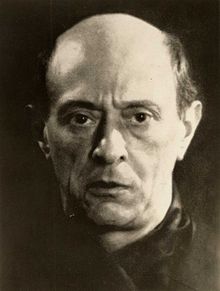Die Glückliche Hand
| Die glückliche Hand | |
|---|---|
| Opera by Arnold Schoenberg | |

The composer in 1927
|
|
| Description | Drama mit Musik |
| Translation | The Hand of Fate |
| Librettist | Schoenberg |
| Language | German |
| Premiere | 24 October 1924 Vienna |
Die glückliche Hand (The Hand of Fate), Op. 18, is a Drama mit Musik ("drama with music") by Arnold Schoenberg in four scenes. It was composed between 1910 and 1913. Like Erwartung, composed a year earlier, it was heavily influenced by Otto Weininger's book Sex and Character. Unlike Erwartung, Schoenberg wrote the libretto for Die glückliche Hand himself. The first performance took place in Vienna on 24 October 1924. The underlying message of the piece is the idea that man continues to repeatedly make the same mistakes, and the plot is developed from events in Schoenberg’s personal life.
The subject of the drama is influenced by personal circumstances in Schoenberg’s life. Schoenberg’s music was not as well received as it had been in previous years. Also, two years before the composition of the piece, Mathilde, Schoenberg’s wife, had an affair with the painter Richard Gerstl and although she returned to Schoenberg this had a lasting effect on their relationship.
The drama represents an inescapable cycle of man's plight as it starts and finishes with the male character struggling with the monster on his back. The male character sings about his love for a young woman (mime) but, despite this love, she leaves him for a well-dressed gentleman (mime). He senses that she has left him and eventually, when she returns, he forgives her and his happiness returns. Again the woman retreats. The woman is seen later with the gentleman, and the male soloist implores the women to stay with him but she escapes and kicks a rock at him. This rock turns into the monster that was originally seen on the man’s back. Thus, the drama ends where it began.
The score calls for: piccolo, 3 flutes (3rd doubling on 2nd piccolo), 3 oboes, English horn, D clarinet, 3 clarinets (in B-flat and A), bass clarinet, 3 bassoons, contrabassoon, 4 horns, 3 trumpets, 4 trombones, bass tuba, timpani, cymbals, bass drum, snare drum, tamtam, high and low bells, triangle, xylophone, glockenspiel, metal tubes, tambourine, hammer, harp, celesta, and strings.
...
Wikipedia
